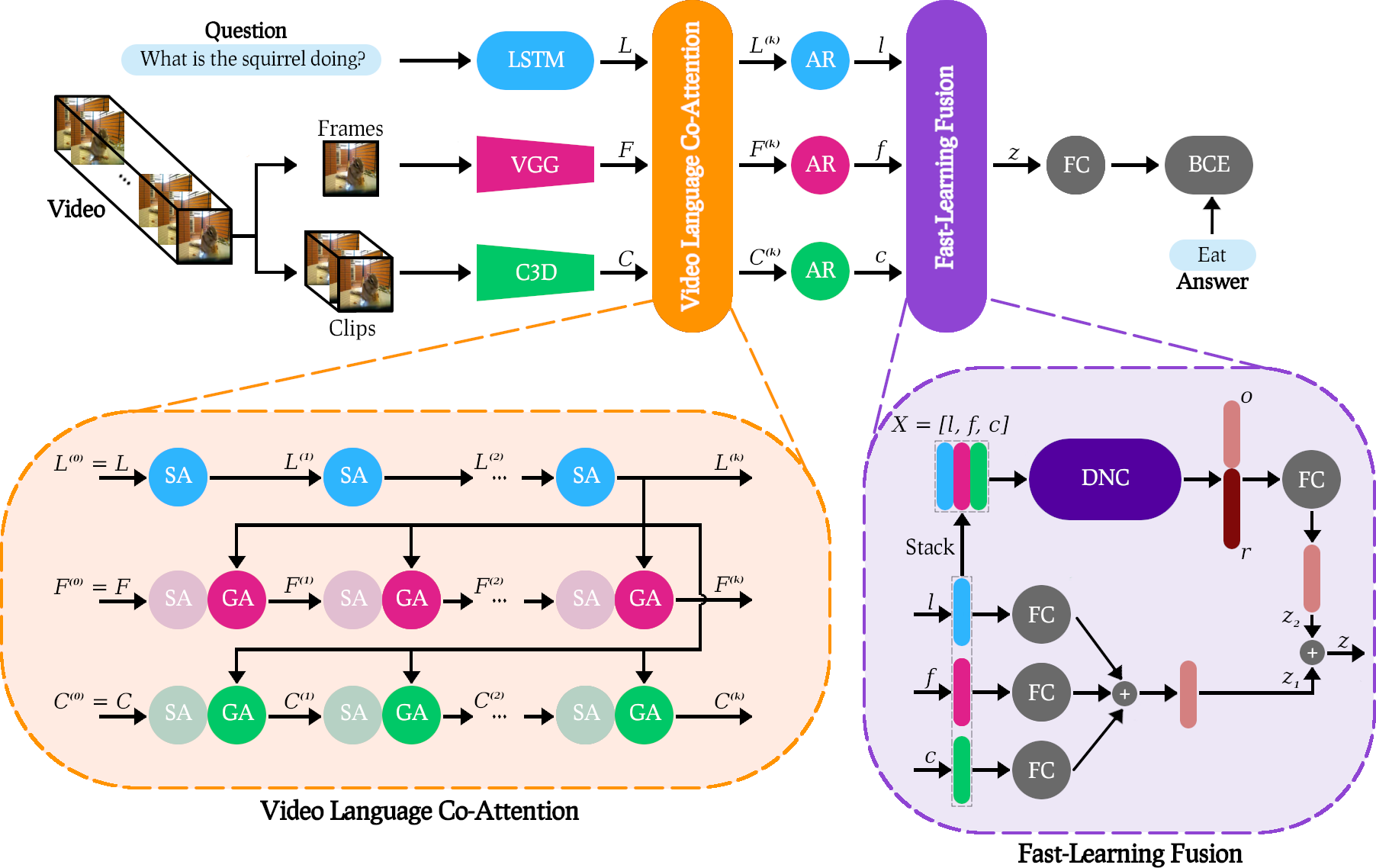| assets | ||
| cfgs | ||
| code | ||
| core | ||
| README.md | ||
| requirements.txt | ||
| run.py | ||
Citation
This is the official code of the paper Video Language Co-Attention with Fast-Learning Feature Fusion for VideoQA. If you find our code useful, please cite our paper:
Overview

Results
Our VLCN model achieves new state-of-the-art results on two open-ended VideoQA datasets MSVD-QA and MSRVTT-QA.
MSVD-QA
| Model | What | Who | How | When | Where | All |
|---|---|---|---|---|---|---|
| ST-VQA | 18.10 | 50.00 | 83.80 | 72.40 | 28.60 | 31.30 |
| Co-Mem | 19.60 | 48.70 | 81.60 | 74.10 | 31.70 | 31.70 |
| HMEMA | 22.40 | 50.00 | 73.00 | 70.70 | 42.90 | 33.70 |
| SSML | - | - | - | - | - | 35.13 |
| QueST | 24.50 | 52.90 | 79.10 | 72.40 | 50.00 | 36.10 |
| HCRN | - | - | - | - | - | 36.10 |
| MA-DRNN | 24.30 | 51.60 | 82.00 | 86.30 | 26.30 | 36.20 |
| VLCN (Ours) | 28.42 | 51.29 | 81.08 | 74.13 | 46.43 | 38.06 |
MSRVTT-QA
| Model | What | Who | How | When | Where | All |
|---|---|---|---|---|---|---|
| ST-VQA | 24.50 | 41.20 | 78.00 | 76.50 | 34.90 | 30.90 |
| Co-Mem | 23.90 | 42.50 | 74.10 | 69.00 | 42.90 | 32.00 |
| HMEMA | 22.40 | 50.10 | 73.00 | 70.70 | 42.90 | 33.70 |
| QueST | 27.90 | 45.60 | 83.00 | 75.70 | 31.60 | 34.60 |
| SSML | - | - | - | - | - | 35.00 |
| HCRN | - | - | - | - | - | 35.60 |
| VLCN (Ours) | 30.69 | 44.09 | 79.82 | 78.29 | 36.80 | 36.01 |
Requirements
- PyTorch 1.3.1
- Torchvision 0.4.2
- Python 3.6
Raw data
The raw data of MSVD-QA and MSRVTT-QA are located in
data/MSVD-QA
and
data/MSRVTT-QA
, respectively.
Videos: The raw videos of MSVD-QA and MSRVTT-QA can be downloaded from ⬇ and ⬇, respectively.
Text: The text data can be downloaded from ⬇.
After downloading all the raw data, data/MSVD-QA
and
data/MSRVTT-QA
should have the following structure:

Preprocessing
To sample the individual frames and clips and generate the corresponding visual features, we run the script
preporocess.py
on the raw videos with the appropriate flags. E.g. for MSVD-QA we have to execute
python core/data/preporocess.py --RAW_VID_PATH /data/MSRVD-QA/videos --C3D_PATH path_to_pretrained_c3d
This will save the individual frames and clips in
data/MSVD-QA/frames
and
data/MSVD-QA/clips
, respectively, and their visual features in
data/MSVD-QA/frame_feat
and
data/MSVD-QA/clip_feat, respectively.
Config files
Before starting training, one has to update the config path file
cfgs/path_cfgs.py
with the paths of the raw data as well as the visual feaures.
All Hyperparameters can be adjusted in
cfgs/base_cfgs.py.
Training
To start training, one has to specify an experiment directory
EXP_NAME
where all the results (log files, checkpoints, tensorboard files etc) will be saved. Futhermore, one needs to specify the
MODEL_TYPE
of the VLCN to be trained.
| MODEL_TYPE | Description |
|---|---|
| 1 | VLCN |
| 2 | VLCN-FLF |
| 3 | VLCV+LSTM |
| 4 | MCAN |
These parameters can be set inline. E.g. by executing
python run.py --EXP_NAME experiment --MODEL_TYPE 1 --DATA_PATH /data/MSRVD-QA --GPU 1 --SEED 42
Pre-trained models
Our pre-trained models are available here ⬇
Acknowledgements
We thank the Vision and Language Group@ MIL for their MCAN open source implementation, DavidA for his pretrained C3D model and finally ixaxaar for his DNC implementation.